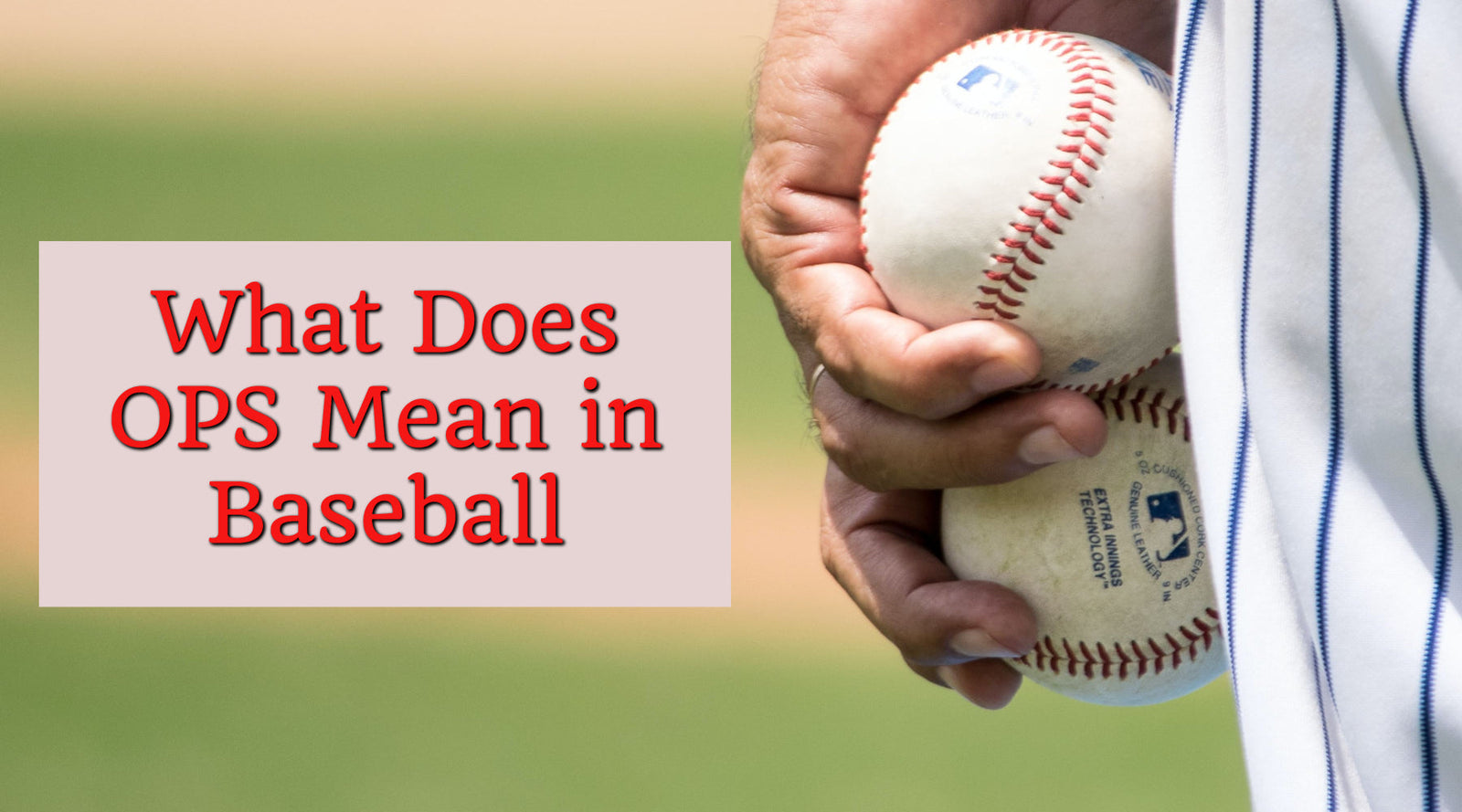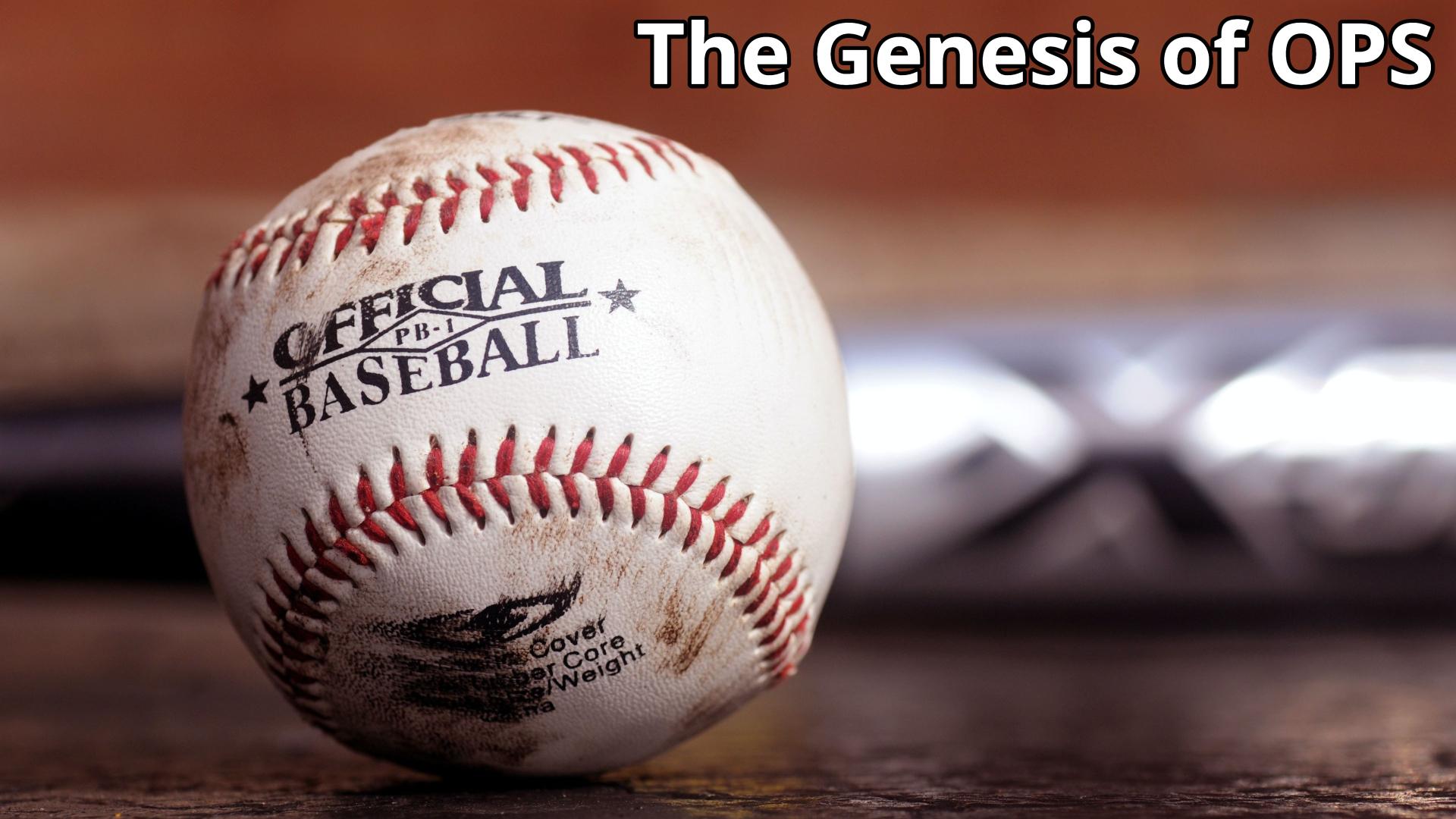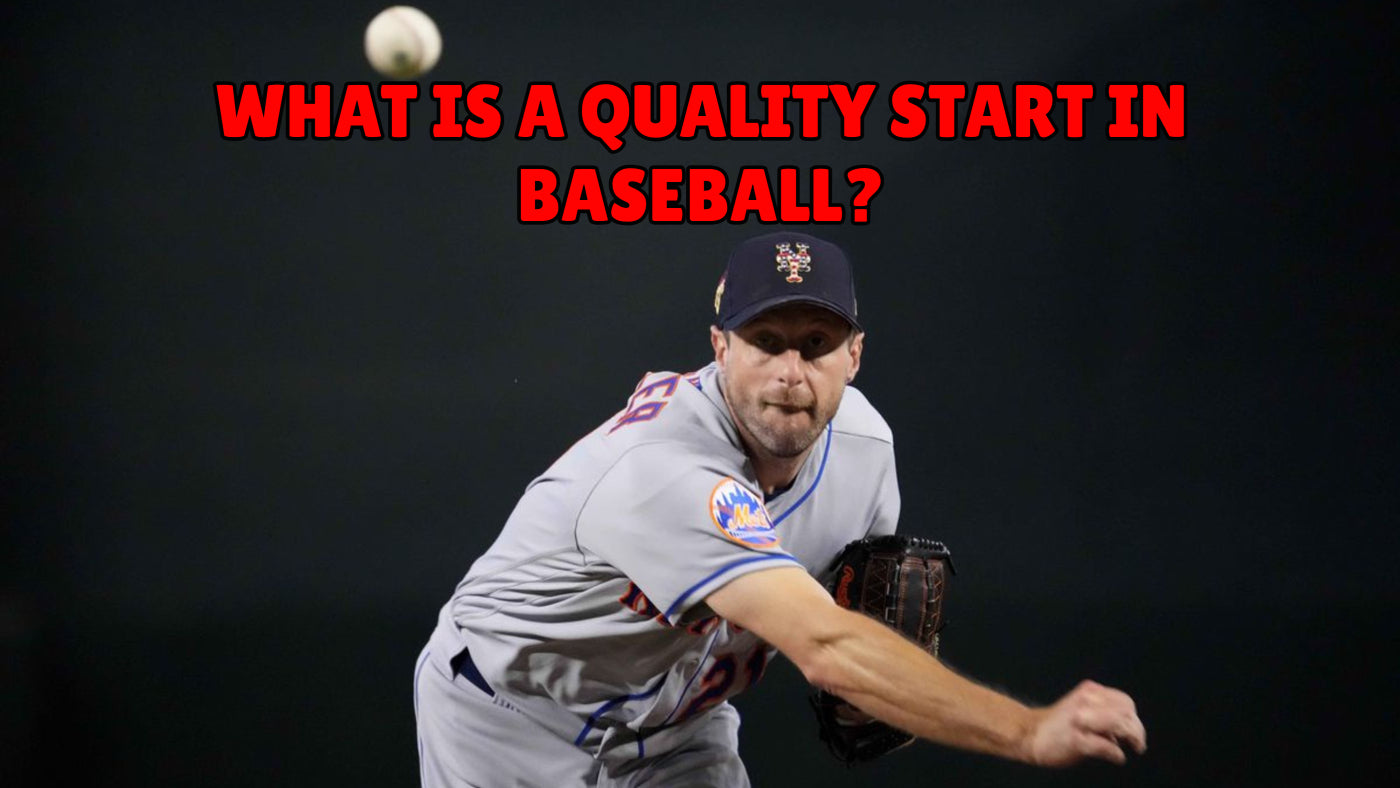Your Cart is Empty
- Mother's Day 🌷
- Gift for Family 🏠❤️
-
Pet
-
Memorial
-
Products
-
Home & Garden
-
Accessories
- Happy Customers ❤️
What Does OPS Mean in Baseball? – Baseball OPS Definition
June 26, 2023 12 min read

Contents
1. The Genesis of OPS 2. Understanding the Components 3. Calculating OPS 4. The Significance of OPS 5. OPS+: The Comparative Advantage 6. OPS and Team Success 7. OPS Leaders: The Greats and the Game Changers 8. The Evolution of OPS: Changing Perspectives 9. Limitations of OPS 10. OPS and the Future of Baseball 11. Who has the highest OPS in baseball 12. Conclusion
Have you ever wondered how baseball analysts gauge a player's offensive performance beyond simple batting average or home run count? In the ever-evolving world of baseball statistics, one metric stands out as the ultimate barometer of a player's hitting prowess - OPS. OPS, short for On-Base Plus Slugging, is a comprehensive measure that encapsulates a player's ability to get on base and hit for power. It has become a key tool for evaluating and comparing players across different eras.
In this article, we'll delve into the intricacies of OPS, unraveling its components, understanding its significance, and exploring how it has revolutionized the game of baseball. So grab your favorite baseball cap, settle into your virtual seat, and join us as we embark on a journey to decode OPS and unlock the secrets behind this ultimate offensive metric.
1. The Genesis of OPS

- The need for a comprehensive metric
In the ever-evolving landscape of baseball analytics, the need for a comprehensive offensive metric became increasingly apparent. Traditional statistics like batting average and home runs provided valuable insights, but they lacked a holistic view of a player's offensive abilities. As the game advanced and analytical minds delved deeper into the nuances of hitting, a new metric emerged - OPS.
- Combining on-base percentage and slugging percentage
OPS is the brainchild of combining two essential metrics - on-base percentage (OBP) and slugging percentage (SLG). OBP measures a player's ability to reach base safely, including hits, walks, and hit-by-pitches. On the other hand, SLG gauges a player's power at the plate by considering the total bases generated from hits.
2. Understanding the Components
- On-Base Percentage (OBP)
OBP reflects a player's knack for getting on base and sustaining offensive momentum. It accounts for hits, walks, and hit-by-pitches while ignoring statistical noise like errors and the fielder's choices. OBP showcases a player's plate discipline, patience, and ability to create scoring opportunities.
- Slugging Percentage (SLG)
SLG focuses on a player's ability to hit for power. It calculates the total bases generated from hits and provides a weighted measure of a player's extra-base hits. SLG captures the essence of doubles, triples, and home runs, illustrating a player's raw hitting ability and run-producing potential.
3. Calculating OPS

The formula for OPS
The simple formula: Calculating OPS is as straightforward as adding OBP and SLG. The formula is as follows:
OPS = OBP + SLG
Interpreting OPS values: OPS values typically range from around .600 for below-average players to well above 1.000 for elite hitters.
The higher the OPS, the more proficient a player is at getting on base and hitting for power. OPS allows for quick comparisons between players and provides a single number that encapsulates their offensive contributions.
4. The Significance of OPS
- Historical context
OPS offers a new lens through which to evaluate players from different eras. Traditional statistics, while valuable in their own right, can be influenced by factors such as ballpark dimensions and the era's prevailing offensive environment. OPS allows analysts to neutralize these external factors and compare players on a level playing field.
- OPS and player evaluation
OPS has become an integral part of player evaluation, both by traditionalists and proponents of advanced analytics. It provides a more comprehensive picture of a player's offensive abilities, transcending the limitations of batting average or home run count. OPS helps teams identify undervalued players, make informed lineup decisions, and guide player development strategies.
5. OPS+: The Comparative Advantage

- Adjusting OPS for park factors
While OPS is an excellent metric, it does not account for the unique characteristics of different ballparks. To address this, OPS+ was introduced. OPS+ adjusts a player's OPS based on the park factors of the stadiums they play in, providing a more accurate measure of their offensive production.
- OPS+ and league-average benchmarks
OPS+ is scaled to the league average, where 100 represents an average hitter. A player with an OPS+ above 100 is considered above average, while values below 100 indicate below-average performance. OPS+ allows for fair comparisons across different seasons and eras, helping identify players who excel relative to their peers.
6. OPS and Team Success
- OPS as a predictor of team performance
Teams with higher OPS values often find themselves in the win column more frequently. OPS serves as a reliable indicator of a team's offensive prowess and run-scoring potential. By maximizing their OPS, teams can create a formidable offensive lineup capable of consistently producing runs and securing victories.
- Case studies of successful teams
Several successful teams have harnessed the power of OPS to achieve their goals. From the "Moneyball" Oakland Athletics to recent World Series champions, OPS has played a crucial role in identifying key contributors and constructing well-rounded lineups. The correlation between high OPS and team success underscores the significance of this metric in building winning rosters.
7. OPS Leaders: The Greats and the Game Changers

- The all-time OPS leaders
When exploring the all-time OPS leaders, names like Babe Ruth, Ted Williams, and Barry Bonds emerge. These legendary hitters showcased their exceptional abilities to reach base and hit for power, setting the bar high for future generations. OPS allows us to appreciate their greatness in a quantitative manner and provides a standard for evaluating contemporary players.
- Modern-day OPS standouts
In the modern era, players like Mike Trout, Mookie Betts, and Christian Yelich have consistently excelled in OPS. These dynamic hitters combine high on-base percentages with impressive slugging abilities, making them formidable forces at the plate. OPS helps identify the current crop of elite hitters and acknowledges their impact on the game.
8. The Evolution of OPS: Changing Perspectives
- OPS vs. traditional statistics
OPS has challenged the prominence of traditional statistics in evaluating offensive performance. Batting average, while still significant, no longer reigns supreme. OPS captures a player's overall offensive contribution and provides a more holistic view of their abilities. This shift in perspective has opened doors to new insights and sparked a revolution in how we understand hitting in baseball.
- The acceptance and integration of OPS
Over time, OPS has gained widespread acceptance among players, coaches, analysts, and fans. It has become a staple in baseball conversations and is prominently featured in broadcasts, articles, and statistical analyses. OPS has transcended its status as a niche metric and is now a fundamental tool for understanding and appreciating the game.
9. Limitations of OPS

- Neglecting baserunning and situational hitting
While OPS captures a player's ability to get on base and hit for power, it does not account for baserunning skills or situational hitting. A player with a high OPS may not excel in stealing bases or advancing on sacrifice flies. OPS, though valuable, should be considered alongside other metrics to gain a comprehensive understanding of a player's offensive contributions.
- OPS and the rise of advanced metrics
As baseball analytics continue to evolve, OPS faces competition from newer metrics that aim to provide an even deeper understanding of player performance. Metrics like weighted on-base average (wOBA) and expected weighted on-base average (xwOBA) seek to refine OPS by incorporating more nuanced factors. While these metrics have their merits, OPS remains a vital and accessible metric for fans and analysts alike.
10. OPS and the Future of Baseball
- OPS in player contracts and transactions
OPS has influenced player contracts and transactions in recent years. Teams are increasingly valuing players with high OPS values, recognizing their ability to generate offense and contribute to team success. As the game progresses, OPS is likely to play a pivotal role in shaping player evaluations, salaries, and roster construction.
- The potential evolution of OPS-based metrics
The landscape of baseball statistics is ever-changing, and OPS-based metrics may continue to evolve. Analysts are constantly seeking new ways to refine and expand upon existing metrics to gain deeper insights into player performance. While OPS has proven its worth, there may be room for future iterations that account for currently overlooked factors and provide an even more accurate representation of offensive abilities.
11. Who has the highest OPS in baseball

Highest OPS by a teenager
When it comes to the highest OPS in baseball, there have been several players throughout history who have left an indelible mark with their exceptional offensive prowess. These players have demonstrated a unique ability to get on base and hit for power, resulting in sky-high OPS values that have set them apart from their peers.
A. Babe Ruth - The Sultan of Swat and the Highest OPS in Baseball

One of the most iconic names associated with the highest OPS in baseball is none other than Babe Ruth. Known as the Sultan of Swat, Ruth's power-hitting prowess revolutionized the game and cemented his status as one of the greatest players of all time. With his towering home runs and exceptional ability to reach base, Ruth consistently boasted an OPS that stood head and shoulders above his contemporaries. His career OPS of 1.164 is a testament to his extraordinary offensive abilities and his dominance during the "Golden Age" of baseball.
B. Ted Williams - A Legend of the Game with an Elite OPS

Another player who etched his name in the annals of baseball history with his remarkable OPS is the legendary Ted Williams. Williams, often hailed as one of the greatest pure hitters in the game, possessed a sublime combination of plate discipline and power. His career OPS of 1.116 ranks among the highest in baseball history and is a testament to his ability to get on base with regularity and hit for both average and power. Williams' meticulous approach at the plate and his unwavering dedication to the craft of hitting earned him the respect and admiration of fans and players alike.
C. Barry Bonds - Unparalleled Power and Patience for a Record-Breaking OPS

Moving closer to the modern era, the name Barry Bonds stands out prominently in discussions about the highest OPS in baseball. Bonds, who holds the single-season record for the highest OPS with an astounding 1.422 in 2002, showcased an unprecedented combination of power and patience. His ability to hit for power and draw walks with incredible frequency made him an offensive juggernaut. Bonds' career OPS of 1.051 solidifies his status as one of the most formidable hitters to ever grace the diamond, and his accomplishments continue to inspire awe and spark debates among baseball enthusiasts.
D. Mike Trout - The Modern Phenom with Consistently High OPS

In recent years, the Los Angeles Angels' Mike Trout has emerged as a player with a consistently high OPS. Trout's blend of power, speed, and plate discipline has propelled him to the top echelons of the game.
Despite his relatively young career, Trout's OPS consistently ranks among the league leaders, showcasing his exceptional hitting abilities. With his uncanny ability to generate extra-base hits and his keen eye for the strike zone, Trout has established himself as one of the premier offensive forces in the game today.
E. OPS as an Indicator of Offensive Prowess in Baseball
While these players have set the bar high with their exceptional OPS values, it's important to note that OPS is not the sole indicator of a player's offensive prowess. Baserunning skills, situational hitting, and other factors contribute to a player's overall offensive impact. However, OPS provides a valuable benchmark and allows fans and analysts to gauge a player's ability to get on base and hit for power in a single metric.
As the game of baseball continues to evolve, new stars will undoubtedly rise to the occasion and etch their names among the players with the highest OPS. The ever-increasing emphasis on analytics and the refinement of hitting techniques could potentially lead to even higher OPS values in the future. Whether it be the legends of the past or the stars of today, the pursuit of the highest OPS in baseball remains a captivating aspect of the game, driving fans to marvel at the remarkable offensive performances that shape the sport's history.
12. Conclusion
OPS has undeniably revolutionized the way we evaluate and appreciate offensive performance in baseball. It combines the fundamental components of on-base percentage and slugging percentage into a single metric, providing a comprehensive view of a player's hitting abilities. OPS has empowered fans, analysts, and teams to understand the game on a deeper level.
As we embark on a new era of baseball, OPS stands tall as the ultimate offensive metric. Its simplicity, accessibility, and ability to capture a player's overall offensive impact make it a valuable tool for everyone from die-hard fans to seasoned analysts. By embracing OPS, we can unlock the secrets behind a player's hitting prowess and appreciate the numbers that define baseball greatness. So next time you watch a game, keep an eye on the OPS leaderboard, and witness the power of this game-changing metric.
⏩ FAQs: Answers to Top Questions about OPS in Baseball:
1. What is good OPS in Baseball?
A good OPS in baseball is typically considered to be above the league average. The league average OPS can vary from season to season, but a generally accepted benchmark for a good OPS would be around .800 or higher. However, it's important to consider the context of the player's position and the league they are competing in, as OPS can vary based on these factors.
2. What is the highest OPS ever?
The highest single-season OPS in Major League Baseball history belongs to Barry Bonds, who achieved an incredible 1.422 OPS during the 2004 season. Bonds' performance that year was exceptional, as he demonstrated a remarkable combination of on-base percentage and slugging.
3. What is the difference between OPS and slugging?
OPS (On-Base Plus Slugging) is a statistic that combines a player's on-base percentage (OBP) and slugging percentage (SLG). Slugging percentage measures a player's ability to generate extra-base hits, while on-base percentage measures their ability to reach base safely. OPS provides a comprehensive measurement of a player's overall offensive performance by combining both aspects.
4. How do I calculate OPS in baseball?
To calculate OPS, you add a player's on-base percentage (OBP) to their slugging percentage (SLG). The formula is: OPS = OBP + SLG. Both OBP and SLG can be obtained by dividing relevant statistics by plate appearances, such as hits, walks, and total bases.
5. Who has the highest OPS in baseball history?
Barry Bonds holds the record for the highest OPS in a single season. However, OPS records can change over time as new players have exceptional seasons or break previous records.
6. What does a 1 OPS mean in baseball?
An OPS of 1.000 is considered excellent in baseball. It signifies that the player has an on-base percentage and slugging percentage of 1.000, indicating a high level of offensive production. An OPS above 1.000 is exceptional, while an OPS below 1.000 is below average.
7. Is a 750 OPS good in baseball?
A 750 OPS in baseball is generally considered around the league average. It indicates a decent level of offensive performance, but it may not be considered outstanding. However, it's essential to consider factors such as the player's position, the context of the league average, and other situational factors when evaluating the significance of a 750 OPS.
8. What is a poor OPS in baseball?
A poor OPS in baseball would typically be below the league average. However, the exact threshold for a poor OPS can vary depending on the context. Generally, an OPS below .700 or significantly below the league average would be considered poor in terms of offensive production.
9. Is OPS better than batting average?
OPS is generally considered a more comprehensive statistic than batting average alone. Batting average only measures a player's success in putting the ball in play, while OPS takes into account both on-base percentage and slugging percentage. OPS provides a more complete picture of a player's offensive contributions and is often preferred for evaluating overall offensive performance.
10. What is the average OPS in MLB?
The average OPS in Major League Baseball can fluctuate from season to season. However, historically, an OPS around .750 to .800 is often cited as the league average. It's important to refer to recent data or statistical reports to determine the most up-to-date average OPS in the MLB.
11. Who is leading MLB in OPS?
The player leading MLB in OPS can change throughout the season as players' performances vary. It's recommended to refer to reputable sports websites, sports news outlets, or official MLB sources for the most current information on the leader in OPS.
12. Is a 1.1 OPS good?
A 1.1 OPS is exceptional in baseball. It indicates an extremely high level of offensive production, showcasing a player's ability to both reach base consistently and generate extra-base hits. A 1.1 OPS is considered among the best in the league and reflects an elite offensive performance.
Thank you for reading the entire blog post on “What Does OPS Mean in Baseball? – Baseball OPS Definition”. If you have any feedback or questions, please feel free to reach out to us at: support@suzitee.com. We appreciate your time and interest!
Related products for Baseball Lovers:
What Does OPS Mean in Baseball? – Baseball OPS Definition

Hazel Edison
Hazel Edison's mission as a content marketer and social media manager is to help businesses connect with their target audience through engaging and informative content. With a deep understanding of the power of digital media, Hazel is committed to helping the brand build its online presence and drive results.
Related articles in Baseball

What Is a Quality Start in Baseball? Understanding the Pitching Metric
August 27, 2023 7 min read
Read More


